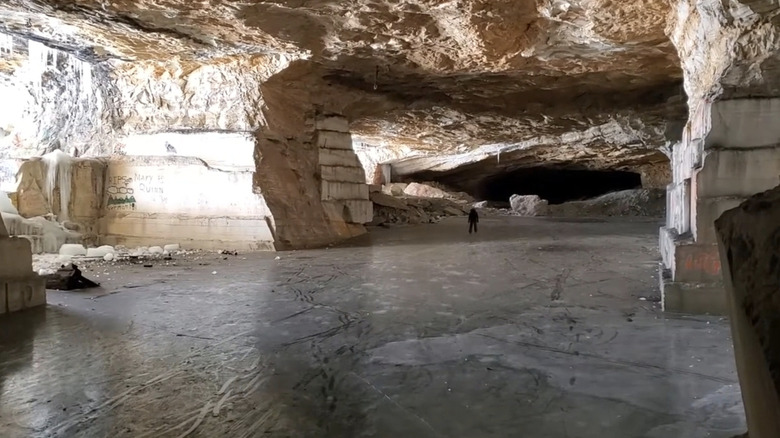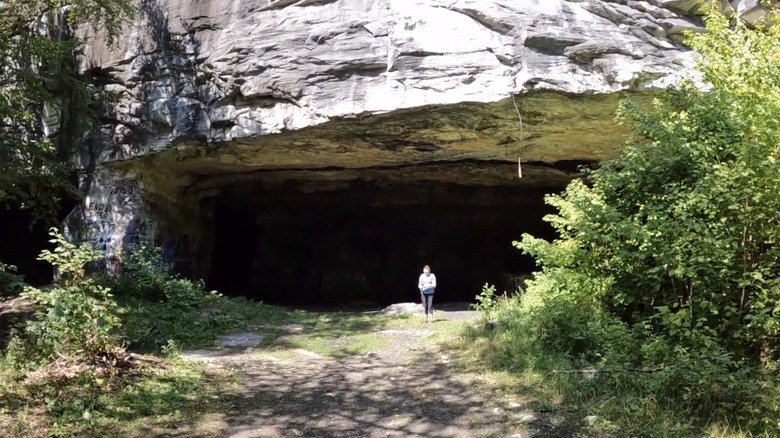Vermont's Giant Marble Quarry Is A Fun Abandoned Tourist Attraction In Dorset Full Of Natural Wonders
When many travelers think of Vermont, towns graced by white steeples and covered bridges may come to mind. One iconic example of this is Bennington, one of Vermont's oldest towns. Another classic Vermont town is Dorset, a four-season destination with cozy New England charm. In its heyday, Dorset was known for its abundance of natural stone — a refined marble with green and blue tones, aptly named Dorset marble. The marble was so popular that it was shipped to New York City and Washington D.C. for building. At one point, it's estimated that Dorset had up to 14 marble quarries. One of these quarries — the now-abandoned Freedlyville Quarry — is a popular destination where visitors can explore vast cave-like ruins.
The Freedlyville Quarry, also called the Freedley Quarry, involves a bit of hiking to get to. It's located up on a slope of Mount Aeolus. At one time, there was a little village established in the woods near the quarry for its workers, which came to be known as Freedlyville. While most quarries are large pits surrounded by rocky cliffs, the Freedlyville Quarry is distinct in that it burrows horizontally into Mount Aeolus, giving it a cavernous quality. Inside this cave is a pond where ice skaters glide over its frozen surface in the winter.
Freedlyville Quarry, then and now
Dorset's marble quarries were first established in 1785, with the discovery of Mount Aeolus' highly sought-after white marble with colorful tints. In 1808, an entrepreneur named Elijah Sykes opened one of the most bountiful marble quarries in the country, owing to its tunnels winding deep into the mountainside. The quarry was eventually bought up by the John K. and William G. Freedley Company of Philadelphia in the mid-19th century and was officially named the Freedley Quarry. The quarry was perched at a high elevation and a gravity railroad system was built to transport the marble down to the mill in the valley below. The community of Freedlyville was built around the mill to accommodate the quarry workers.
Freedlyville Quarry, along with the other marble quarries in Dorset, came to a screeching halt in the 1920s when cheaper alternatives to marble came into popularity. Mills were demolished, houses were abandoned, and quarries sat empty. Though it has been defunct for many years, remnants from its glory days still remain today, such as pieces of the railway system, old building equipment, and blocks of marble in the forest. The quarry's lasting legacy is in the town of Dorset itself, where the sidewalks and house foundations are made from the marble these quarries once supplied.
Explore Freedlyville Quarry and beyond
Freedlyville Quarry isn't exactly a readily accessible attraction. There's a small parking lot off Dorset Hill Road, and from there, you have to hike along a former roadbed for about 1.25 miles to get to the quarry. Note that there are some steep inclines along the trail. You'll see the quarry's entrance right alongside the trail. If you keep hiking on the trail just past the quarry, there's also a lovely lookout point with views of Vermont's Green Mountains.
There are various passages within the quarry that make it thrilling to explore. Any time of year, the quarry has its draws. Visit in the warmer months and you can take advantage of the various hiking trails around the mountain and go swimming in Emerald Lake, about a 10-minute drive from the quarry parking lot. In the fall, you can tour the incredible New England foliage surrounding the cavern and mountain. And in the winter, when the quarry is transformed by icicles and frost, bring your ice skates and glide on the frozen pond surrounded by towering caverns. The town of Dorset is relatively easy to get to if you're traveling from out of state, located 90 minutes from Albany International Airport (ALB).


